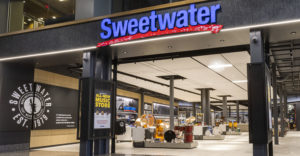
From enterprise search to Web search, technology is rapidly advancing the ability of users to find information faster and with more accuracy than ever. While millions of dollars are being made on search, there’s a strong case to be made that e-commerce search offers the most direct return on investment.
A stack of studies say e-tailers that upgrade their search report higher conversion rates, higher order sizes — in short, more profitability.
Founded in 1997, Mercado Software claims to be the first e-commerce search vendor. Today, it employs 56 people in four U.S. and one overseas office, and while it has had a “laser” approach on e-commerce search since its inception, CEO and President Corey Leibow said today’s e-commerce companies are looking for more than just accurate search results. As a result, Mercado is helping to advance merchandising solutions aimed at giving businesses the ability to change offers and promotions in real time and based on their own business intelligence data.
With a customer roster that includes massive multi-channel retailers such as JC Penney, Target, Sears, OfficeMax, Pottery Barn and Tower Records, as well as a growing number of small and mid-sized e-commerce sites that opt for Mercado’s hosted services option, Mercado is seeing significant growth, adding 11 major customers during the first quarter.
Leibow, who joined Mercado in January of 2005, spoke to the E-Commerce Times in the midst of a road trip that took him to the firm’s software development offices in Israel, where new releases of Mercado’s products are being finalized, and to New York and Boston for meetings with analysts and customers.
He said the most significant shift in e-commerce search and related fields is that while just a few years ago, adoption of such applications was being driven by technology departments, today demand is coming from the top, as business people have come to recognize the value of using customer queries to boost sales, increase profitability and provide their e-commerce channel the same level of branding and merchandising attention their stores and catalogs have long received.
E-Commerce Times: In your travels, you talk to a lot of major e-commerce companies. What is the state of the industry as it relates to e-commerce search?
Corey Leibow: The momentum that’s been created has been extraordinary. There is a confluence of events and developments that are making this happen. Number one, large multi-channel retailers are really figuring out that e-commerce is by far the fastest-growing and largest opportunity to grow their customer base and revenue. We’re seeing a large uptick in investment from large multi-channel retailers. At the same time, small and mid-sized pure-play e-commerce sites — in the US$1 million to $20 million annual sales range — are also coming on board. Literally, we are adding customers there every week.
ECT: What specifically are they seeking from Mercado and your fellow search vendors?
Leibow: These customers are really trying to figure out how to differentiate themselves from the rest, not just by focusing on price and availability but the ability to have a unique customer experience, to create value for the customer. We have solutions that are incredibly cost-effective and it’s opened their eyes to the fact that they can afford to do things that will really change the customer experience on their site.
ECT: Given the competitive nature of the e-commerce landscape, is that an easy sell, or do e-commerce executives still need to be convinced or have the benefits explained to them?
Leibow: It doesn’t take more explaining. What’s happening is that they come to us with unique business problems now, as opposed to a couple years ago when they came to us with technology problems. Now it’s business problems. The business leaders are the ones initiating the search for better technology. But search technology is the tip of the iceberg. It’s what gets us in the door. What they are really interested in and what they really want to understand and know about is what we call our merchandising technology. It’s not enough to get someone to the right product now. It’s what you surround that with, how you get them to look at up-selling to a store brand or higher brand, how to get people to add more to their shopping carts with related products, how you focus their attention in a way that’s unobtrusive. Maybe it’s how they can promote a particular brand name that is offering them a discount or bonus. They’re looking for ways to increase average order size and increase brand loyalty.
ECT: The goal is to increase value of each customer’s every visit, then?
Leibow: A lot of companies are spending significantly on search engine marketing. They’re paying a lot of money in some cases to have the right to get someone to click on their site. When they do get them to the site, they have to sell more than they might been have inclined to buy in order to make that visit and transaction profitable.
ECT: So you see search as just one part of a larger problem you’re helping to solve through organization of data.
Leibow: Right. Search is just the beginning in a lot of ways. Another big area is our taxonomy solution, which focuses on creating the right categories and populating them with the right attributed products — all from disparate catalogs and information. In essence, they’re looking to create a unified catalog that is attributed correctly and normalized correctly. It’s the old adage — garbage in, garbage out. There’s a tremendous amount of value in making sure information is accurate and in the right place, especially when a company is dealing with multiple brands and multiple types of products. To be able to figure out how to synergize and normalize in order to create search and navigation and merchandising solutions that work on that product set is something that we’ve been able to help a lot of customers with even before they get to applying search to their sites. We also help companies bridge the gap between their business intelligence data and their Web site operations. A lot of them have tons of data and they look at it and say, ‘this is interesting,’ but they don’t know how to translate it into changes they can make on their site.
ECT: How have user expectations about search changed and what does that mean for e-commerce companies?
Leibow: You have a whole generation growing up on Google and Yahoo. They’re expecting an experience that is much more accurate and responsive to what they put into it. They have zero tolerance for incomplete or no results. It’s been proven through some specific stats that if an end customer goes onto a site, does a search and gets no results, she’ll go right back to the original search engine and look for another retailer.
ECT: It sounds like you see a lot of growth ahead.
Leibow: Some of our customers are seeing double-digit growth year after year in the e-commerce channel. JC Penney just went past the billion-dollar sales mark on the online channel. Just think about globalization and the fact that your customer can literally be at any given moment any place in the world and still shop at your online store. The Federal Expresses of the world have the ability to almost completely eliminate the immediate gratification issue by being able to ship things overnight or in two to three days. It’s a completely new market for them and they are eager to put the resources into it now to make the most of it. The days of the e-commerce channel being the poor stepsister are over.
























































Social Media
See all Social Media